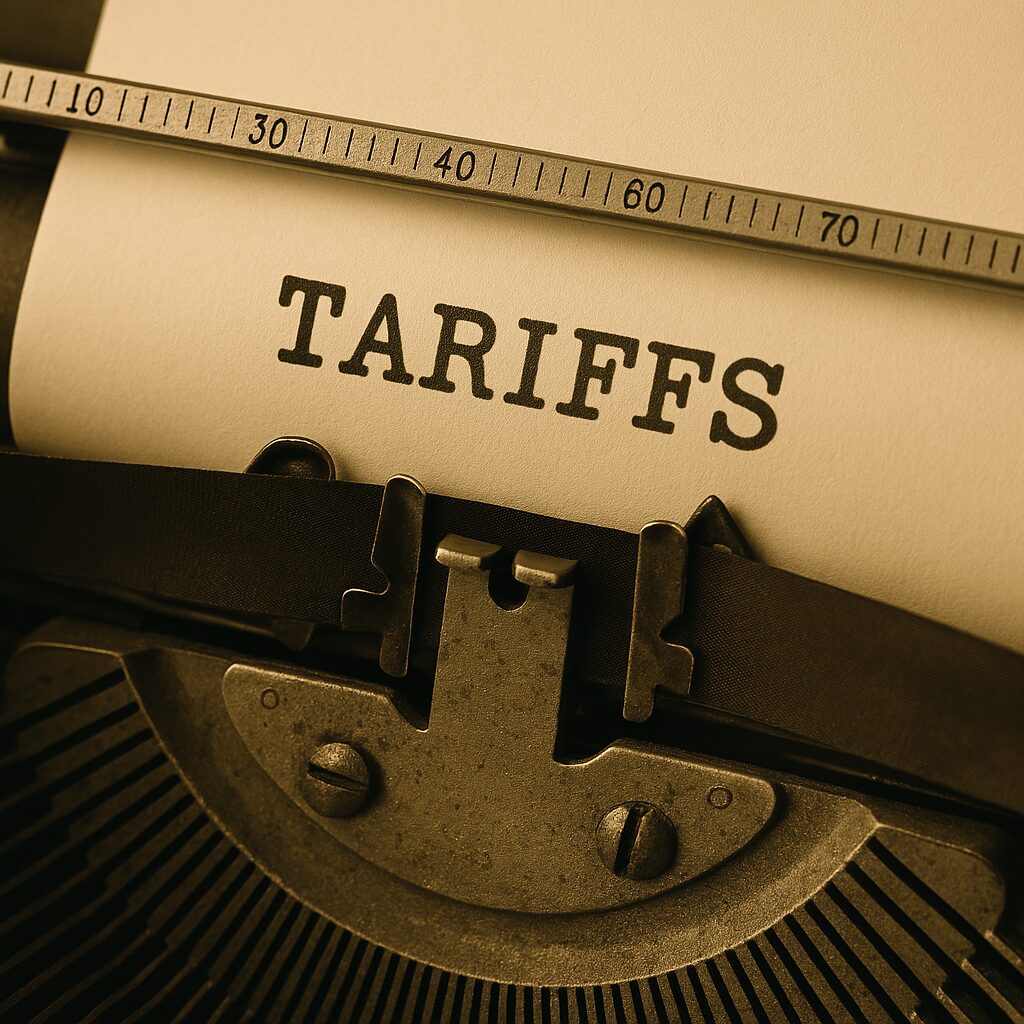I’ve worked in corporate retail for over 20 years as a buyer, planner and senior marketing manager and I’ve bought everything from apparel to shoes, food to electronics, housewares to cameras, so I know exactly how tariffs and retail pricing mess with your wallet.
From $5 Temu makeup to $35 frying pans, let’s break it down in plain English.
No math degree required, just real talk.

What Are Tariffs, and Why Do They Stack?
A tariff is a tax the U.S. slaps on imported goods. Think of it like a punishment fee just for being foreign. And here’s the kicker:
tariffs stack

Let’s say you’re importing a frying pan that is made of aluminum but has a stainless steel coating because that’s actually a thing you can buy at Target or WalMart:
- 25% tariff for aluminum = $2.00
- 25% for steel = another $2.00
- 20% just for being made in China = $1.60
That $8 factory pan now costs $13.60 before it even gets on the boat.
Now let’s go big. Think about a MacBook. The retail price is around $1,200, but Apple is known for having a tight markup—about 5–8%. I know this because I’ve bought Apple products from Apple when I worked as a buyer at HSN, so I’m not just making that up.
That means the factory cost is somewhere between $1,100 and $1,140. I’ve put the specs there so you can see what it’s made out of, because facts.

Apply the same tariff logic to a MacBook that is made of aluminum and has stainless steel screws:
- 25% aluminum = $275
- 25% stainless steel = $275
- 20% for being made in China = $220
That’s $770 in tariffs stacked on top. So a MacBook that cost Apple $1,100 to make in their factory now costs nearly $1,870 before shipping, warehousing, or any other costs.
New Apple MacBook Retail Price: $2,020
Still wondering why Apple raised prices, cut accessories, and leaned into U.S. assembly? This is why. How much do we think Apple is paying their people to put stainless steel screws in their aluminum laptop cases?
Don’t worry, we’ll get into that a little later.
When Gross Margin Gets Crushed
Let’s go back to that MacBook example. If the factory cost with tariffs jumps to $1,870 and Apple tries to keep the retail price at $1,200 to avoid shocking customers, here’s what happens:
- Gross profit = $1,200 – $1,870 = – $670
Yep, they’d be losing almost $700 on every sale.

Now imagine you’re a smaller brand or a startup. You’re not Apple. You don’t have billions in the bank or massive market share.
When your gross margin shrinks like that, you can’t keep prices flat without sacrificing something, or in some cases, everything.
That something could be:
- Cutting staff or hours
- Closing stores
- Slashing marketing budgets
- Letting customer service suffer
- Pausing e-commerce tools or subscriptions
- Seriously, it pays to keep the damn lights on
Gross margin doesn’t just float in the finance department—it funds everything. When it disappears, the whole business model starts unraveling.
So no, keeping prices flat isn’t some consumer win—it’s the beginning of the end for a lot of businesses. When companies keep prices the same in a high-tariff world, it’s not a win for you—it’s a red flag that the business might not be sustainable for long.
And Then Come the Port Fees
Under new rules? The U.S. just tacked on another $1.5 million port fee per ship.
Let’s go back to those rising costs—because it’s not just frying pans. Imagine that same $1.5 million port fee being applied to a shipment carrying higher-end items like MacBooks. If a container has 500 MacBooks and you divide that fee across them, you’re looking at $3,000 per container or $6 per MacBook just to get it off the ship.
Doesn’t sound like much? Stack that on top of the $770 in tariffs and it adds up—especially when Apple’s markup is razor thin. Multiply that by tens of thousands of units and you start to understand why brands have to either increase prices, cut corners, or find somewhere else to eat the cost.

But back to the pan example:
If the ship carries 10,000 containers and only 10% of them are pans?
You’re adding $0.60 per pan just to unload it.
Final landed cost: $14.20
Want to keep the same markup and stay profitable? That pan that used to sell for $19.99 now has to sell for $35.48. Nearly double.
If the brand doesn’t raise the price? They lose $6.20 per unit. Sell 2,432 pans like that, and you’ve just lost the equivalent of one full-time minimum wage job.
The Costs No One Wants to Talk About
Alright, let’s talk about what really drives up retail prices—the stuff no one wants to put on a corporate earnings call.
Labor. Fuel. Shipping. Repeat.

Let’s start with labor. Do we think companies are paying top dollar to people putting together goods in America? Absolutely not. But even at minimum wage or just above, domestic labor costs are way higher than what overseas factories pay. If companies do shift manufacturing back to the U.S., they’re also taking on OSHA compliance, health insurance, and other overhead. That means higher prices unless they’re cutting corners somewhere else.
Now let’s talk fuel. Once something lands at the port, it doesn’t teleport to a shelf. It’s trucked or trained to a warehouse, then trucked again to stores or final destinations. Gas prices have already gone up 1.5% in the last two weeks, and that increase hits every single mile. That adds up fast across tens of thousands of deliveries—especially for bulky or heavy goods.
Even running an e-commerce site costs money: servers, transaction fees, fraud prevention, shipping software, returns processing, etc. All of it cuts into profit.
So while tariffs and port fees are the headline, it’s the quiet creep of fuel and labor that’s really strangling margins behind the scenes. And once those costs go up, they don’t come back down.
De Minimis: The Temu & Shein Rule That’s Ending May 2
Until now, anything under $800 shipped to the U.S. from overseas got in duty-free under the “de minimis” loophole.
That’s how you got 10 pieces of clothing for $50 from Temu with no extra fees.
But starting May 2:
A flat $25 per item
You’ll be charged 30% of the item price OR

Whichever is more.
That $3 lip gloss? $28. That $5 shirt? $30.
Bought 10 items for $50? You could now owe $250 in duties.
“But This Will Bring Jobs Back! Make America Great Again!”
To where? West Virginia? For $7.25/hour gluing plastic soles on shoes?
Let’s be real. No one’s going to take a national minimum wage job when they can’t even afford the gas to get there. And don’t say, “Mexicans will do it.”
First of all, you just got rid of them.
And second, Florida literally weakened child labor laws just to fill jobs. So now we’re depending on teenagers to make fast fashion while chanting “America First.”
Make it make sense.
“At Least American Brands Will Stay Cheap, Right?”
If imported prices are $35, do you honestly think American brands are going to stay at $19.99 out of the kindness of their capitalist hearts?
Delulu is the solulu.
No. They’ll raise prices too—and blame it on inflation, labor, or shipping costs. They’ll match the new norm and keep the extra cash.
This is how the rich get richer. That’s what capitalism is.

FAQ: Tariffs and Retail Pricing
Q: What is a tariff?
A tax on imported goods. U.S. companies have to pay it, and it usually gets passed down to you.
Q: What is the de minimis rule?
It let you receive overseas packages from places like Temu under $800 without paying customs. That’s ending May 2.
Q: Who does this hurt most?
Everyday shoppers. Budget-conscious folks, students, parents—especially those who rely on low-cost imports.
Q: Does this really bring back American jobs?
Not without paying people livable wages or fixing immigration policy. Right now, it’s more about optics than outcomes.
Q: What are some items made with both aluminum and steel?
Here are some everyday items and consumer goods that use aluminum for structure and steel for strength or fastening:
- MacBooks & other laptops – aluminum casing for sleek design and cooling; steel screws and hinges inside
- Cookware (like frying pans) – aluminum for fast, even heating; steel handles or rivets for durability
- Smartphones – aluminum bodies with internal steel plates for protection and magnetic parts
- Cars & trucks – aluminum panels to reduce weight; steel frames, axles, and internal parts for strength
- Bicycles & scooters – aluminum frames for lightness; steel bolts, bearings, or brake components
- Power tools – aluminum housing to dissipate heat; steel gears and shafts for torque
- Appliances (microwaves, blenders, etc.) – aluminum in the motor housing or paneling; steel screws, motors, and blades
- Furniture – aluminum legs or arms; steel fasteners or support frames
Q: What’s a “markup”?
Markup is how much a company adds on top of what it paid to make or buy something. If a factory makes a frying pan for $8, and the store sells it to you for $24? That extra $16 is the markup. Markup helps cover things like rent, payroll, shipping, and—let’s be real—shareholder profits.
Q: What does ‘cost’ mean?
This is how much it costs a company to make or purchase an item before any markup, shipping, or packaging. Think of it as the bare-bones cost.
Q: What is ‘retail price’?
This is the price you pay in the store or online. It includes the factory cost, shipping, marketing, profit margin, and sometimes a sprinkle of “just because we can.”
Q: What’s a ‘margin’?
Margin is the amount a company like Target adds to the cost of an item they bought from a Factory to make a profit. If something costs $10 to make and they sell it for $30, the margin is $20.
Q: What is ‘gross margin’?
Gross margin is a percentage that tells you how much profit a company makes before paying overhead (like rent, staff, etc.). It’s calculated like this:
(Gross Profit ÷ Retail Price) x 100.
Let’s break that down with an example:
Imagine a product has a factory cost of $10 and it’s sold for $30.
- Gross profit = $20
- Gross margin = ($20 ÷ $30) x 100 = 66.6%
Now let’s say tariffs raise that factory cost to $18, but the company keeps the retail price at $30:
- New gross profit = $12
- New gross margin = ($12 ÷ $30) x 100 = 40%
That’s a huge drop in margin—and most companies won’t tolerate that. Instead, they raise the price to maintain the same gross margin. That’s how you end up paying $35 instead of $19.99.
Q: What is a tariff?
A tax on imported goods. U.S. companies have to pay it, and it usually gets passed down to you.
Q: What is the de minimis rule?
It let you receive overseas packages under $800 without paying customs. That’s ending May 2.
Q: Who does this hurt most?
Everyday shoppers. Budget-conscious folks, students, parents—especially those who rely on low-cost imports.
Q: Does this really bring back American jobs?
Not without paying people livable wages or fixing immigration policy. Right now, it’s more about optics than outcomes.
TL;DR: Tariffs and Retail Pricing Aren’t Just Business Problems
They’re your problem.
- Retail prices go up
- Small businesses suffer
- Shoppers pay more
- Jobs don’t magically appear
- And fast fashion might not even be fast anymore
So no, this isn’t just a “China thing.”
It’s a you’re-about-to-pay-$28-for-lashes thing.


Leave a Reply